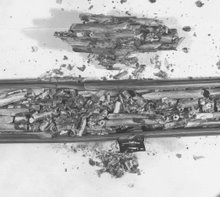
The above report is a fantastic disclosure, and I will be pleased to be corrected, but all of this seems to have gone on without any attention from our NRC.
 The above view is from the Oxenford report page 13. It is very interesting that this 1999 data is first released 6 or 7 years later, and it is the first time anyone has openly disclosed that main condenser inleakage may be among the root causes of fouling.
The above view is from the Oxenford report page 13. It is very interesting that this 1999 data is first released 6 or 7 years later, and it is the first time anyone has openly disclosed that main condenser inleakage may be among the root causes of fouling. The above slide from Oxenford, page 16, is explicitly labelled, "After Chronic Condenser Leak." On page 4 of his June, 2006, white paper, Oxenford discloses, "Our concerns resurfaced in 1999 following fuel failures at the River Bend plant (admiralty brass condenser with deep bed demineralizers). We closely tracked the River Bend cause analysis. River Bend corrosion had high copper levels, but the failures were attributed to high iron levels in their corrosion layer. Based on Columbia being a low iron plant, no action was taken."
The above slide from Oxenford, page 16, is explicitly labelled, "After Chronic Condenser Leak." On page 4 of his June, 2006, white paper, Oxenford discloses, "Our concerns resurfaced in 1999 following fuel failures at the River Bend plant (admiralty brass condenser with deep bed demineralizers). We closely tracked the River Bend cause analysis. River Bend corrosion had high copper levels, but the failures were attributed to high iron levels in their corrosion layer. Based on Columbia being a low iron plant, no action was taken."Although Columbia was allowed to track the fouling investigations at River Bend during 1999, River Bend issued a voluntary Licensing Event Report on March 1, 2000, as noted below. River Bend made it very clear that it was issuing the LER only as a voluntary activity. Indeed, subsequent severe fouling at River Bend was not reported as an LER and only came to light in presentations to technical societies and outside of the purview of NRC.
Readers may find the River Bend LER on the NRC web site as directed below. The LER is somewhat misleading, there is a lot of fog in the discussion of root cause. Although this River Bend LER refers to fouling and fuel element failures at other plants, there is no disclosure that inleakage via the main condenser was found to be a significant root cause of fouling at the Columbia Generating Station.


No comments:
Post a Comment